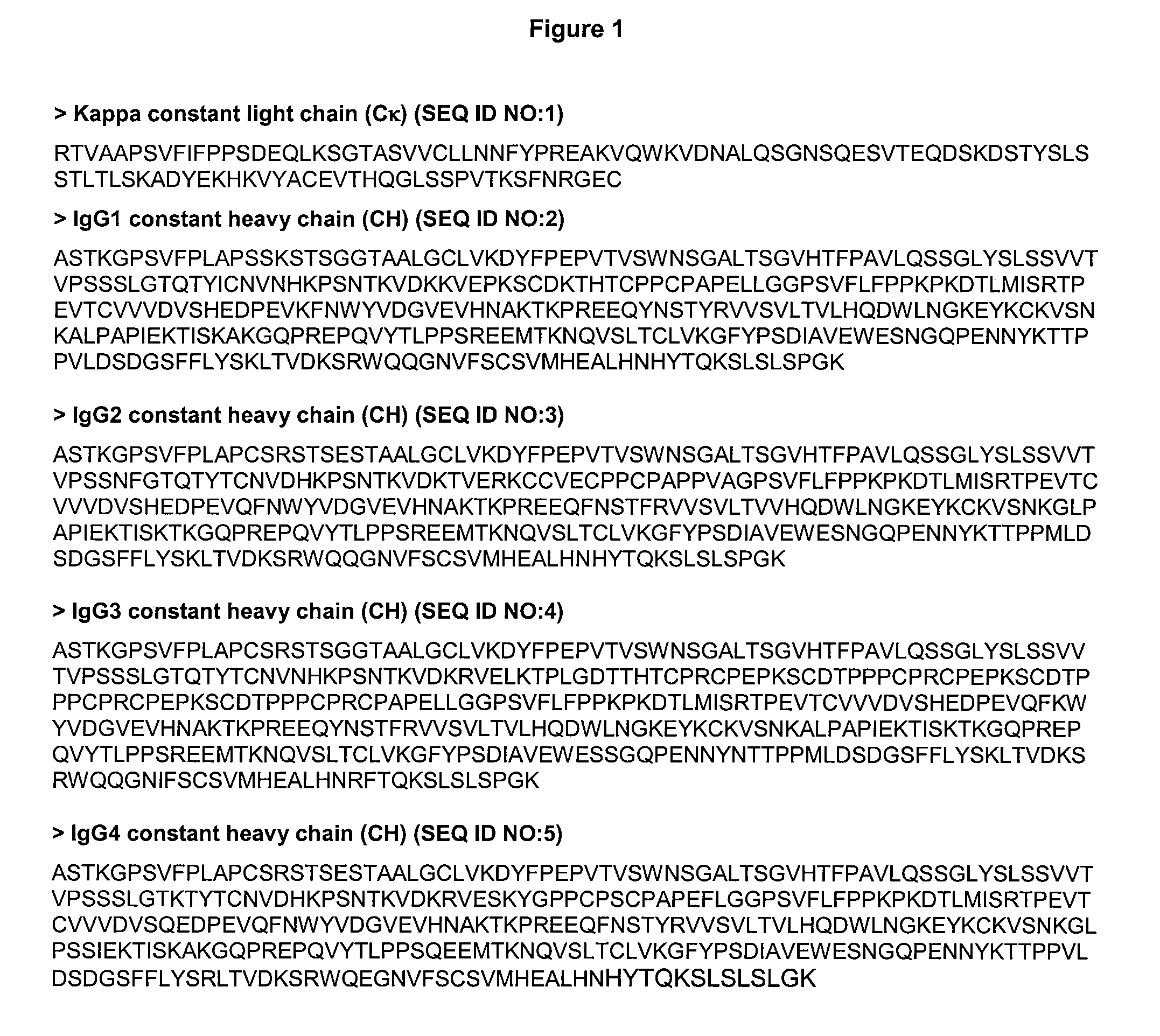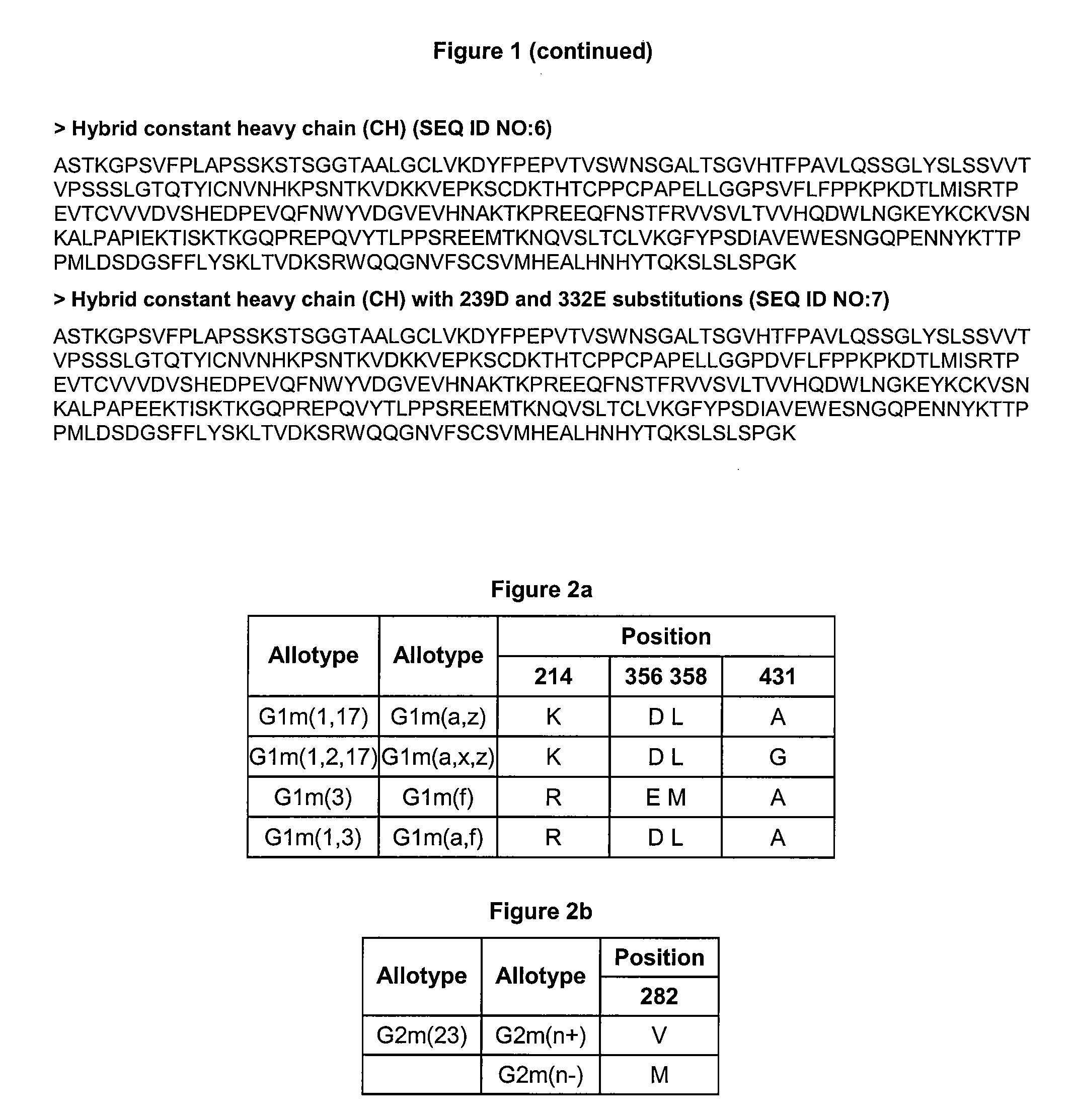Optimized ca9 antibodies and methods of using the same
a technology of ca9 antibodies and antibodies, applied in the field of optimized ca9 antibodies and, can solve the problems of high restriction and limited expression, and achieve the effect of reducing the binding to fcriib
- Summary
- Abstract
- Description
- Claims
- Application Information
AI Technical Summary
Benefits of technology
Problems solved by technology
Method used
Image
Examples
example 1
Anti-CA9 Antibodies with Amino Acid Modifications that Enhance Effector Function
[0251]The anti-CA9 antibodies of the invention are intended as clinical candidates for anti-cancer therapeutics. To investigate the possibility of improving the effector function on an antibody that targets CA9, variant versions of anti-CA9 antibody G250 (Oosterwijk et al., 1986, Int J Cancer 38:489-494, incorporated in its entirety herein by reference) were engineered.
[0252]Sequences of the heavy and light chain variable regions of the G250 antibody, obtained from U.S. Ser. No. 10 / 470,940, incorporated in its entirety herein by reference, are provided in FIGS. 5a and 5b. The genes for murine WT G250 VH and VL, designated H0 and L0 respectively, were constructed using gene synthesis techniques and subcloned into the mammalian expression vector pcDNA3.1Zeo (Invitrogen) comprising the full length light kappa (Cκ) and heavy chain IgG1 constant regions. Variant S239D / I332E was constructed in the Fc region of...
example 2
Anti-CA9 Antibodies with Reduced Potential for Immunogencity
[0255]Variants of the H0 / L0 anti-CA9 antibody were generated to reduce immunogenicity in humans by applying a string optimization algorithm, as described in U.S. Ser. No. 11 / 004,590, entitled “Methods of Generating Variant Proteins with Increased Host String Content and Compositions Thereof”, filed on Dec. 6, 2004. This algorithm heuristically samples multiple amino acid mutations that exist in the diversity of the human VLκ and VH germline sequences, and calculates the host string content (HSC). Variant sequences were also evaluated for structural and functional integrity using a nearest neighbor structure-based scoring method (U.S. Ser. No. 60 / 528,229, filed Dec. 8, 2003, entitled “Protein Engineering with Analogous Contact Environments,” incorporated in its entirety herein by reference). Novel variant heavy chain and light chain sequences, referred to as H1 and L1 respectively, were chosen to characterize experimentally....
example 3
Optimized anti-CA9 Antibodies
[0258]Examples of anti-CA9 antibodies of the invention with optimized properties are provided in FIG. 7. FIGS. 7a and 7b provide the sequences of a full length H1 / L1 G250 IgG1 S239D / I332E antibody. Although human Cκ IgG1 is the most commonly used constant region for therapeutic antibodies, other embodiments may utilize constant regions or variants thereof of other IgG immunoglobulin chains. These include but are not limited the lambda constant chain (Cκ), and any of the four IgG isotypes IgG1, IgG2, IgG3, and IgG4 (provided in FIG. 1). Variant versions of IgG constant chains may also find use in the anti-CA9 antibodies of the invention. For example, FIG. 1 provides the sequence of a hybrid IgG1 / IgG2 antibody that may be used. FIGS. 7a and 7c provide the sequences of a full length H1 / L1 G250 Hybrid S239D / I332E antibody.
PUM
| Property | Measurement | Unit |
|---|---|---|
| molecular weight | aaaaa | aaaaa |
| molecular weight | aaaaa | aaaaa |
| time | aaaaa | aaaaa |
Abstract
Description
Claims
Application Information
 Login to View More
Login to View More - R&D
- Intellectual Property
- Life Sciences
- Materials
- Tech Scout
- Unparalleled Data Quality
- Higher Quality Content
- 60% Fewer Hallucinations
Browse by: Latest US Patents, China's latest patents, Technical Efficacy Thesaurus, Application Domain, Technology Topic, Popular Technical Reports.
© 2025 PatSnap. All rights reserved.Legal|Privacy policy|Modern Slavery Act Transparency Statement|Sitemap|About US| Contact US: help@patsnap.com



